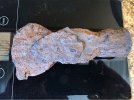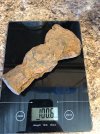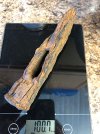- Joined
- Dec 24, 2016
- Messages
- 3,371
There is some background in my previous Unearthed Axe head thread
https://www.bladeforums.com/threads/so-i-unearthed-some-old-axe-heads.1463473/
Similar situation here. When we were planting beans late this spring, I noticed some debris in the field mostly bricks, rocks and occasionally some
old iron. While picking up in the area my cousin pulls this out of the ground and tossed it in the pile and FAILED TO MENTION IT TO ME UNTIL NOW !



Honestly I’m not exactly sure what I’m looking at but I damn sure like it. I’ve never seen a piece of iron with this many flakes to it.
What next, leave it as is, knock off the biggest flakes, vinegar soak for a day, electrolysis soak ?
https://www.bladeforums.com/threads/so-i-unearthed-some-old-axe-heads.1463473/
Similar situation here. When we were planting beans late this spring, I noticed some debris in the field mostly bricks, rocks and occasionally some
old iron. While picking up in the area my cousin pulls this out of the ground and tossed it in the pile and FAILED TO MENTION IT TO ME UNTIL NOW !



Honestly I’m not exactly sure what I’m looking at but I damn sure like it. I’ve never seen a piece of iron with this many flakes to it.
What next, leave it as is, knock off the biggest flakes, vinegar soak for a day, electrolysis soak ?




